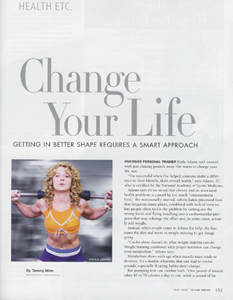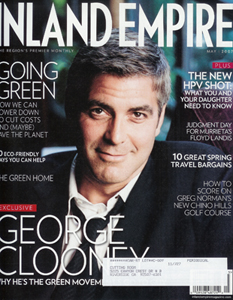GETTING IN BETTER SHAPE REQUIRES A SMART APPROACH
Inland Empire Magazine
By: Tammy Minn

 RIVERSIDE PERSONAL TRAINER Karla Adams isn’t content with just chasing pounds away. She wants to change your life, too. “I’m successful when I’ve helped someone make a difference in their lifestyle, their overall health,” says Adams, 27, who is certified by the National Academy of Sports Medicine. Adams says it’s no secret that obesity and its associated health problems is caused by too much “entertainment food,” the nutritionally-starved, calorie-laden processed food that frequents many plates, combined with lack of exercise. But people often tackle the problem by cutting out the wrong foods and flying headlong into a cardiovascular program that may sabotage the effort and, in some cases, actually add weight. Instead, when people come to Adams for help, she fine tunes the diet and turns to weight training to get things going. “Cardio alone doesn’t do what weight training can do. Weight training combined with proper nutrition can change your metabolism,” Adams says. Metabolism slows with age when muscle mass tends to decrease. It’s a double-whammy that can lead to excess pounds, especially if eating habits don’t change. But pumping iron can combat both. “One pound of muscle takes 40 to 70 calories a day to run, while a pound of fat requires almost none. If you do weight training right, you could be burning an extra 300 to 400 calories a day,” Adams says, by increasing muscle mass and decreasing freeloading fat.
RIVERSIDE PERSONAL TRAINER Karla Adams isn’t content with just chasing pounds away. She wants to change your life, too. “I’m successful when I’ve helped someone make a difference in their lifestyle, their overall health,” says Adams, 27, who is certified by the National Academy of Sports Medicine. Adams says it’s no secret that obesity and its associated health problems is caused by too much “entertainment food,” the nutritionally-starved, calorie-laden processed food that frequents many plates, combined with lack of exercise. But people often tackle the problem by cutting out the wrong foods and flying headlong into a cardiovascular program that may sabotage the effort and, in some cases, actually add weight. Instead, when people come to Adams for help, she fine tunes the diet and turns to weight training to get things going. “Cardio alone doesn’t do what weight training can do. Weight training combined with proper nutrition can change your metabolism,” Adams says. Metabolism slows with age when muscle mass tends to decrease. It’s a double-whammy that can lead to excess pounds, especially if eating habits don’t change. But pumping iron can combat both. “One pound of muscle takes 40 to 70 calories a day to run, while a pound of fat requires almost none. If you do weight training right, you could be burning an extra 300 to 400 calories a day,” Adams says, by increasing muscle mass and decreasing freeloading fat.
Studies have shown that adults who do not strength train lose between five to seven pounds of muscle every decade. Besides building muscle, weight training has been shown to improve bone mineral density, as well as improving glucose metabolism, a factor in diabetes. Researchers have reported a 23 percent increase in glucose uptake after four months of strength training. In addition, a study conducted at the University of Alabama took a group of men and women (61 to 77 years of age) and had them participate in a three-day per-week strength-training program for six months. After six months, the ironpumpers got much stronger, lost 6 pounds of fat, gained 4.5 pounds of lean tissue, started participating in more leisure time activities on a regular basis and had 12 percent increase in total energy expenditure (total calories burned per day). They burned about 230 additional calories per day compared to when they started the study.
Adams isn’t surprised. She has seen similar results in her own clients. Nancy Mitchell is one example. A former aerobics instructor and marathon runner, the Lorna Linda wife, mother and sales representative couldn’t figure out why she was gaining weight, even though she was running about 35 miles a week and watching her calories. Frustrated, she consulted with Adams who tweaked Mitchell’s diet and pointed her to the weight room. Three years later and 40 pounds lighter, Mitchell is a believer. At 51, she has appeared-bikini-clad-in magazines and will compete in her first body-building competition this year. To help her train, Adams referred her to a friend, former Mr. America , Jason Kozma. Mitchell thanks Adams for getting her started and changing her life. “I think a lot people get in the mindset that because they’re over 40, there’s nothing they can do to stop the middle-aged weight gain. But you can,” Mitchell says. She credits Adams with showing her how. “What impressed me about Karla was her knowledge. She knew exactly what I needed. She is so enthusiastic and passionate about what she does, it rubs off on you,” Mitchell says.
Dale Kinnear, principal at Riverside ‘s John W. North High School , echoes Mitchells sentiment. In 2003 at 298 pounds, Kinnear decided to do something about his weight. He consulted with Adams who worked out a program to get him started. He wasn’t used to exercising, let alone weight training, but Adams staned slowly. “At first, I really couldn’t do much. A short stint on the stationary bike, a few lunges while holding on to something for balance and lifting some light weights was plenty for me to manage.” But 16 months later, he could do 30 push-ups balancing his hands on a ball instead of placing them flat on the floor. Now he’s up to 100 of those. He’s now lost about 97 pounds and makes good nutrition and exercise a pan of his daily life. He credits Adams for keeping him motivated. “She mixes a spoonful of advice, a cup of cardiovascular challenges, pounds of weightlifting, a taste of nutrition with plenty of enjoyment to create a fitness program that brings results,” Kinnear says.
While most of Adams ‘s clients want to lose weight, the numbers on the scale are just pan of the equation. Body fat is an important factor, as is overall health. “Our society is obsessed with weight and wanting to get thinner. But it’s really about satisfaction and if you feel like you’re at your best. Are you fit and strong? Do you feel healthy? Do you like the way your clothes fit? That’s what we should be focusing on,” she says. Nutrition, not extreme diets, are high on her menu. “We really are what we eat,” says Adams, who first became interested in nutrition when she got a job in a health food store as a teenager.
For most people, Adams recommends a daily menu of three to five servings of lean protein, five servings of fruits and vegetables, and three servings of carbohydrates, preferably from natural or whole grain sources, such as brown rice. But fruits and vegetables, high on the list, are key to good health. Sadly, they are grossly neglected in our society, she notes. “Fruits and vegetables contain certain enzymes that help with digestion and, therefore, metabolism, that you can’t get anywhere else,” Adams says. They also boost fiber intake, which she notes is dismal in most Americans’ diets. “We’re supposed to have between 30 and 35 grams per day; most people get between five and 10,” she notes. Without proper nutrition, the metabolism slows down and your body develops “empty cravings-salt and fat, for example,” Adams says. Your body may be lacking sodium or other naturally-occurring minerals, so your brain signals your stomach and you find yourself asking for French fries with ketchup. After working as a personal trainer for a corporate gym, Adams started her own business four years ago. She is also working with Riverside Community College to produce an exercise program for the school’s TV channel and writes a nutritional column for the Lorna Linda Lopers, a running, walking and fitness club.
But one of her favorite things is taking part in the City of Riverside ‘s Sister City program. As co-chair of the Sendai , Japan committee, she speaks as enthusiastically about building friendships and forging cultural relations as she does about building strong bodies and changing lives. She’s participated in the Sendai half marathons and is looking forward to future activities the city is planning with the Sendai delegation. In the meantime, Adams is spreading the word about health and fitness throughout the community, doing seminars at high schools as well as working with clients to meet their needs. For some, that might mean touching base monthly, while others want weekly instruction. “It depends on what’s best for you,”
Adams says. Regardless, the end result she hopes for is a change in perspective. “When you are physically fit and feel good about yourself, it bleeds into all other aspects of your life. It makes you driven in everything. You start thinking like an athlete, because you are. When you I train hard, you’re an athlete,” Adams says. “It’s never too late to start.”



